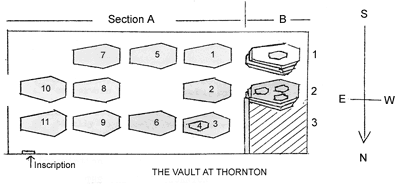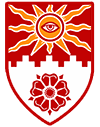They are arranged in lines of 10 adult coffins and one of a child (number 4, resting on number 3). The outer wooden caskets have rotted away, leaving only fragile pieces of wood on top of the lead containers. Several of these are bursting or have fallen in, and traces of an inner wooden coffin can be seen. Each lead container bears in raised letters the same inscription as engraved upon the brass plates fixed to the top of the outer wooden casket. These inscriptions are as follows: –
1. Leigh Smith, died March 16 1827. Aged 68 years
2. Thomas Sheppard Bart. died November 21st 1821. Aged 75 years
3. Elizabeth Sheppard wife of Thomas Sheppard Esq., Died September 27 1800. Aged 42 years
4. Charles Sheppard. Died July 25 1801. Aged 3 years
5. W.T. Sheppard Cotton Esq., Died April 21st 1803. Aged …. (not legible on lead, and brass missing) N.B. 24 years.
6. Maria Lowndes wife of William Lowndes Esq., of Whaddon Hall. Died December 14 1798. Aged ….. years. N.B. 22 years
7. Reverend George Turnor of Wragley 2nd son of the late Edmund Turnor, Esq. of Panton House, Lincs. Died at Thornton Hall October 5 1825. Aged 65
8. Ann Eleanora Turnor. Died Feb 22 1845. Aged 82
9. Sarah Gurney. Died March 20 1809 ………… (plate missing)
10. Dame Mary Ann widow of Sir Thomas Cotton Sheppard Bart. of Crakemarsh Hall. Died September 26 1872 in her 80th year
11. Sir Thomas Cotton Sheppard Bart. Died 5 April 1848. Aged 63
Section ‘B’ – The Tyrell Vault
Here are two piles of coffins:
1. Three lead containers for adults, and on top of them a wooden one for a small baby.
The only one which has any isible marking is the topmost adult one, having a brass fixed on the side at its foot end, with the inscription: “Sir Charles Tyrrell Bart. Died Jan 20th 1748. Aged 40”
2. Three adult lead containers, and on top of them three wood coffins for children, with brass studding and traces of a leather covering. These latter were split open and showed inside a few fragments of cloth, and one or two light green metal spicules – presumably the remains of shroud pins. As the bodies were of small children, the skeletons would have been largely cartilage, and this has decomposed to leave practically no trace. The uppermost large coffin still has its outer brass-studded wooden container more or less intact, with fragments of its original leather covering. None in this pile has any discoverable inscription.
3. In the corner, and contained by pile 2 and a three foot high single brick wall, is a heap composed of mouldering wood, coffin handles and fittings and assorted bones.
Conclusions
It would appear that the Tyrrell vault mentioned by Browne-Willis, wherein were interred “no less than six baronets and some of their ladies and children; of above 30 …. in number”, was beneath the north chantry as he states when describing the chantry, “In this chapel is a vault.”
When this chantry was demolished by Dr Cotton (ob.1782) or his son-in-law Thomas Sheppard, it was desirous of discontinuing using the vault – it may have been no longer structurally sound -. So Thomas Sheppard built a new one alongside the nave where the north aisle had previously stood, and over this, the north aisle was built in 1850. The two piles of coffins and the heap of remains at the far end of the vault must surely be what remained of the Tyrrell interments, moved into the new vault, the other rows of coffins containing the remains of Thomas Sheppard and his family. Leigh Smith and Sarah Gurney presumably had some connection with the family, but at present, that is unknown. The others fit in as follows:-




